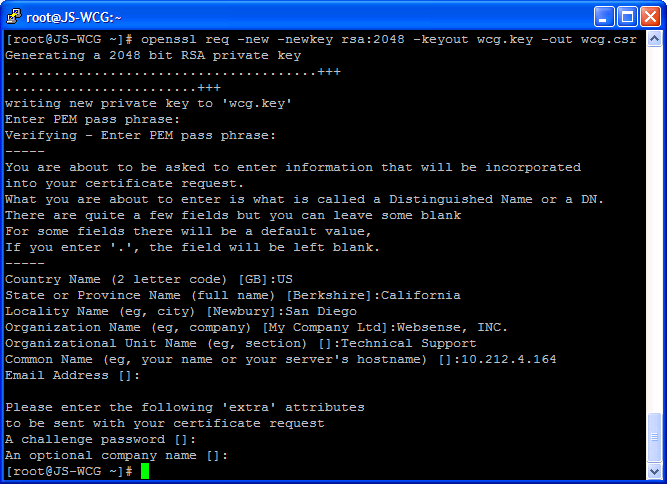Openssl Generate Key Pair Rsa
If you're using openssl_pkey_new() in conjunction with openssl_csr_new() and want to change the CSR digest algorithm as well as specify a custom key size, the configuration override should be defined once and sent to both functions:
<?php
$config = array(
'digest_alg' => 'sha1',
'private_key_bits' => 2048,
'private_key_type' => OPENSSL_KEYTYPE_RSA,
);
$privkey = openssl_pkey_new($config);
$csr = openssl_csr_new($dn, $privkey, $config);
?>
Although openssl_pkey_new() will accept the 'digest_alg' argument it won't use it, and setting the value has no effect unless you also set this value for openssl_csr_new(). The reason for this is that the $config array is acting as a drop-in replacement for the values found in the openssl.cnf file, so it must contain all of the override values that you need even if the function they're being sent to won't use them.
Also, if you change the 'digest_alg' to something like 'sha256' and still get an MD5 signed CSR check your openssl.cnf file to see whether the digest algorithm you want to use is actually supported.- Openssl Generate Key Pair Rsa Login
- Openssl Generate Key Pair Rsa Number
- Openssl Generate Key Pair Rsa Code
- Openssl Generate Rsa Private Key
- The standard OpenSSH suite of tools contains the ssh-keygen utility, which is used to generate key pairs. Run it on your local computer to generate a 2048-bit RSA key pair, which is fine for most uses. Ssh-keygen The utility prompts you to select a location for the keys.
- One way to do this is to generate a DER encoded key using OpenSSL's asn1parse command's -genconf option. You'll need to construct an input file for asn1parse -genconf to produce an RSA key in the standard format (per RFC 3447).
The private key is generated and saved in a file named 'rsa.private' located in the same folder. Generating the Public Key - Linux 1. Open the Terminal. Type the following: openssl rsa -in rsa.private -out rsa.public -pubout -outform PEM 2. The public key is saved in a file named rsa.public located in the same folder.

Download and install the OpenSSL runtimes. If you are running Windows, grab the Cygwin package.
OpenSSL can generate several kinds of public/private keypairs.RSA is the most common kind of keypair generation.[1]
Other popular ways of generating RSA public key / private key pairs include PuTTYgen and ssh-keygen.[2][3]
Generate an RSA keypair with a 2048 bit private key[edit]
Execute command: 'openssl genpkey -algorithm RSA -out private_key.pem -pkeyopt rsa_keygen_bits:2048'[4] (previously “openssl genrsa -out private_key.pem 2048”)
e.g.
Make sure to prevent other users from reading your key by executing chmod go-r private_key.pem afterward.
Openssl Generate Key Pair Rsa Login
Extracting the public key from an RSA keypair[edit]
Execute command: 'openssl rsa -pubout -in private_key.pem -out public_key.pem'
e.g.
A new file is created, public_key.pem, with the public key.
It is relatively easy to do some cryptographic calculations to calculate the public key from the prime1 and prime2 values in the public key file.However, OpenSSL has already pre-calculated the public key and stored it in the private key file.So this command doesn't actually do any cryptographic calculation -- it merely copies the public key bytes out of the file and writes the Base64 PEM encoded version of those bytes into the output public key file.[5]
Viewing the key elements[edit]
Execute command: 'openssl rsa -text -in private_key.pem'
All parts of private_key.pem are printed to the screen. This includes the modulus (also referred to as public key and n), public exponent (also referred to as e and exponent; default value is 0x010001), private exponent, and primes used to create keys (prime1, also called p, and prime2, also called q), a few other variables used to perform RSA operations faster, and the Base64 PEM encoded version of all that data.[6](The Base64 PEM encoded version of all that data is identical to the private_key.pem file).
Password-less login[edit]
Often a person will set up an automated backup process that periodically backs up all the content on one 'working' computer onto some other 'backup' computer. /how-do-security-key-generators-work.html.
Openssl Generate Key Pair Rsa Number
Because that person wants this process to run every night, even if no human is anywhere near either one of these computers, using a 'password-protected' private key won't work -- that person wants the backup to proceed right away, not wait until some human walks by and types in the password to unlock the private key.Many of these people generate 'a private key with no password'.[7]Some of these people, instead, generate a private key with a password,and then somehow type in that password to 'unlock' the private key every time the server reboots so that automated toolscan make use of the password-protected keys.[8][3]
Openssl Generate Key Pair Rsa Code
Further reading[edit]
- ↑Key Generation
- ↑Michael Stahnke.'Pro OpenSSH'.p. 247.
- ↑ ab'SourceForge.net Documentation: SSH Key Overview'
- ↑'genpkey(1) - Linux man page'
- ↑'Public – Private key encryption using OpenSSL'
- ↑'OpenSSL 1024 bit RSA Private Key Breakdown'
- ↑'DreamHost: Personal Backup'.
- ↑Troy Johnson.'Using Rsync and SSH: Keys, Validating, and Automation'.
- Internet_Technologies/SSH describes how to use 'ssh-keygen' and 'ssh-copy-id' on your local machine so you can quickly and securely ssh from your local machine to a remote host.